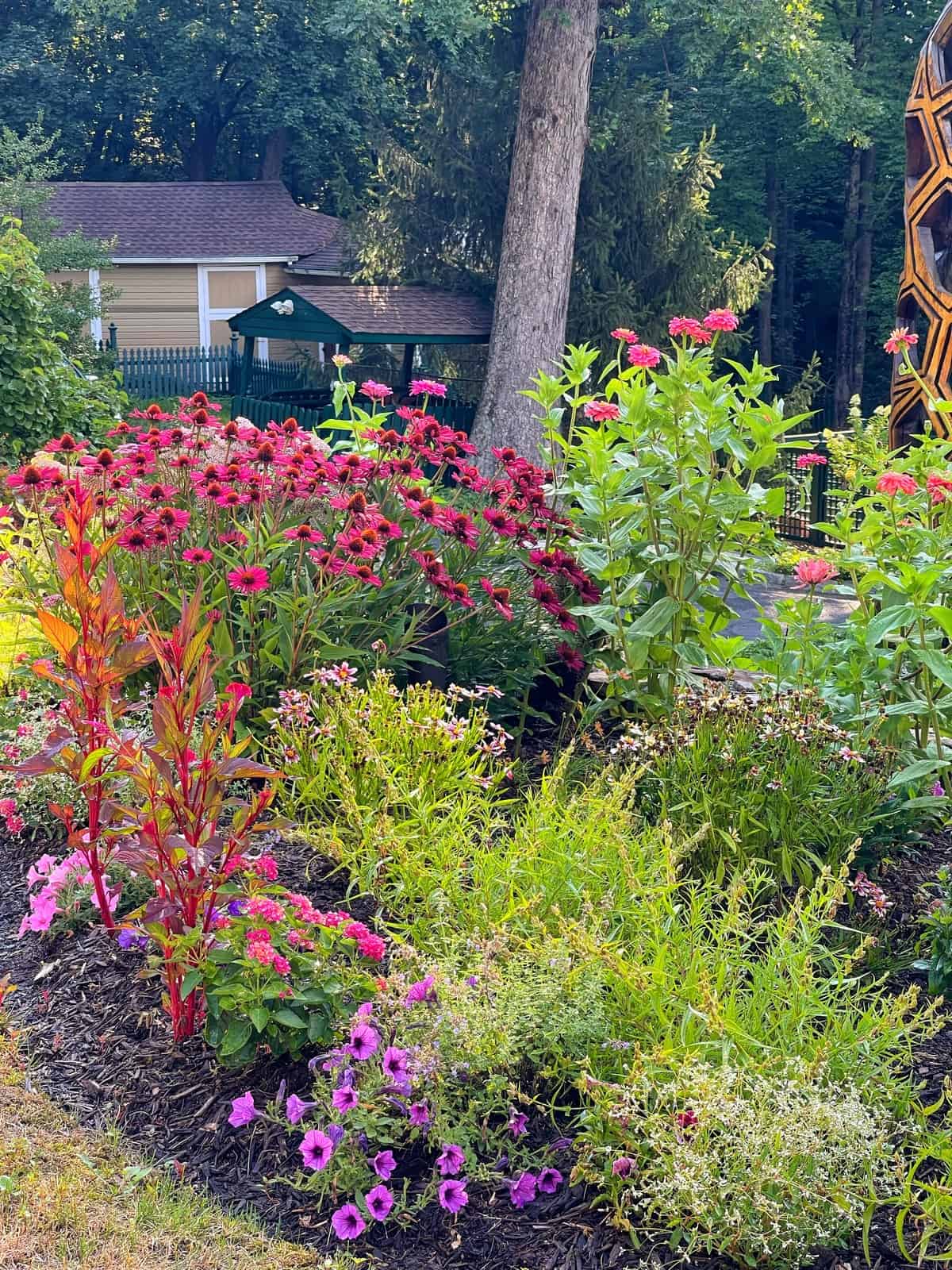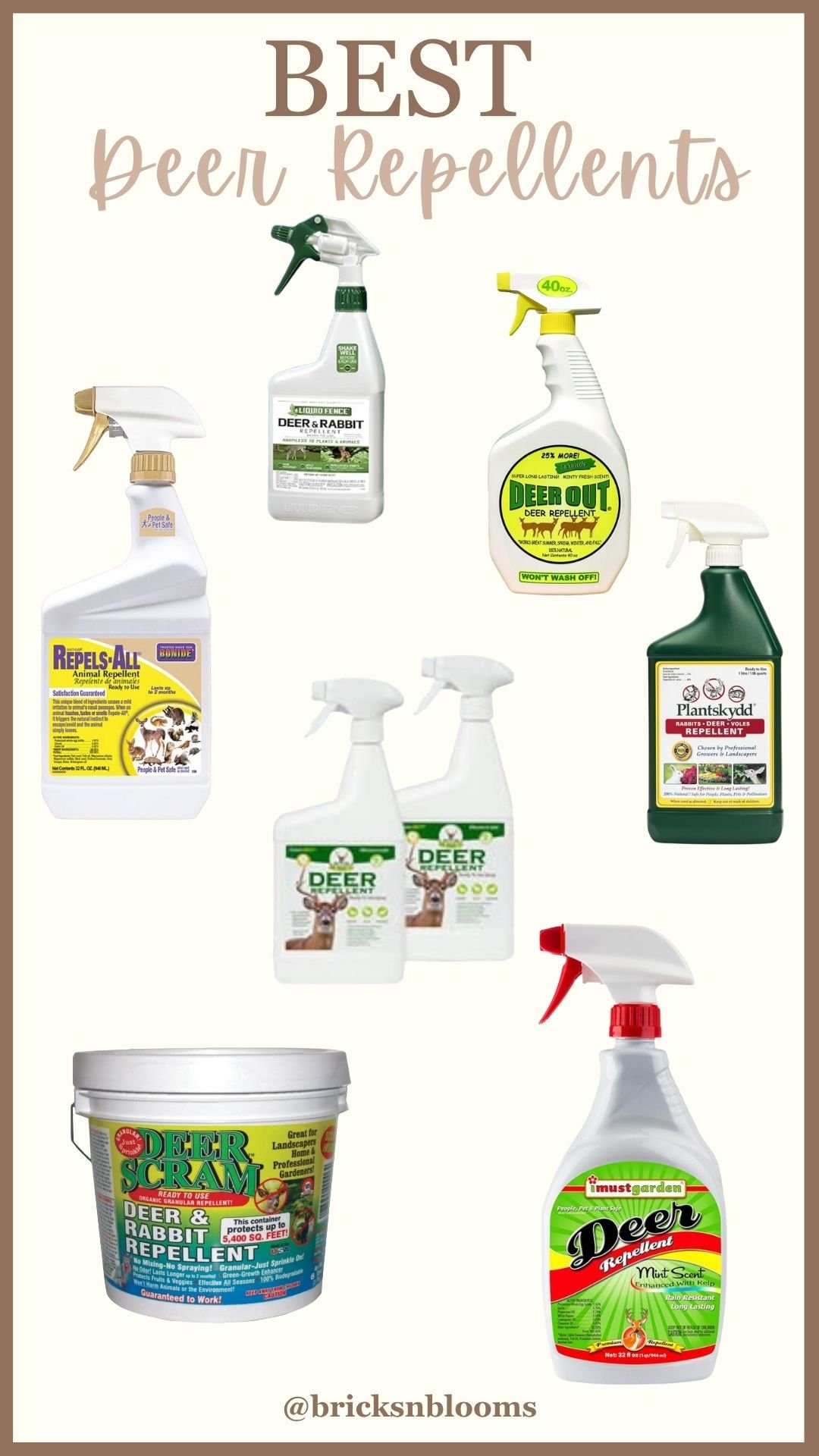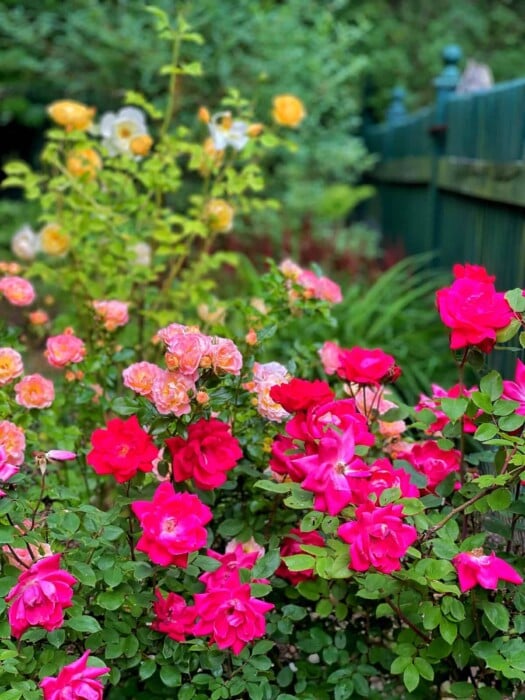Protect your flower garden from damage with this buyer’s guide to the BEST deer repellents of 2025. Sprays, granules, and more! Read on to reclaim your flower patch!
For a gardener or gardening enthusiast, there is nothing worse than planting a beautiful garden filled with flowers or vegetables only to find the next morning they’ve been eaten to a nub.
Has this happened to you too?
It is so frustrating when deer have your home and garden on their path, decimating flowers, and going on their merry way. I’ve been battling them for over 25 years and have found that a number of techniques work to keep them at bay.
The most effective way to keep them out is to erect an eight-foot fence around your garden, but that isn’t always physically or financially feasible. So what’s a gardener to do?
Deer repellent sprays and granules are very effective when used properly. And I’ve found that it’s helpful to find the right one that works for you. I use them all the time in my New Jersey zone 6b gardens and they work really well when applied correctly and often.
So today, I’m sharing my favorite deer repellents that I use religiously all the time, plus a few others that I tried and found to be effective.
I’m sharing my thoughts and views on each product so you can make the best choice as to what will work best for you in your gardens.
Are you ready? Let’s go!
(Posts on stacyling.com may contain affiliate links. Click HERE for full disclosure.)

What You Need to Know About Deer to Choose the Best Repellent
When it comes to understanding deer behavior and developing effective strategies to protect your garden, there are a few things to understand. Here’s what you need to know.
Deer Vision: How it Impacts Your Yard
To keep deer out of gardens, it’s best to use an eight-foot or higher fence. Because yes, they can jump over anything lower than that. But did you also know that deer lack depth perception? They rely on their keen senses of hearing, smell, and motion detection to navigate their surroundings.
This characteristic can be used to your advantage when implementing deterrents because you can erect a double fence to keep them out.
In my former garden, we had a split rail fence that enclosed the backyard. Just inside that fence in the back corner where the shed was, we added a small fenced garden for growing vegetables. Deer were very active in my backyard gardens but never jumped in that garden. And I attribute it to the double fencing. They didn’t think they could make it in and never tried.


Deer Smell Everything: Protecting Plants with Odor Deterrents
Deer have a strong sense of smell and are sensitive to certain odors. They are naturally repelled by strong scents like human urine, predator scents, or certain plant aromas. Incorporating these odors into your garden can help deter them from approaching and damaging your plants. This is why deer repellents work so well when used correctly.
Stop Deer Damage: Break Their Trail with Repellents
Deer tend to follow established pathways, especially when foraging for food. They develop habitual routes that they use repeatedly. By understanding their travel patterns, you can strategically use repellents and/or place deterrents or barriers along these paths to dissuade them from entering your garden.
You can also include plants they tend to leave alone. Believe it or not, there are lots of options out there that are beautiful, flower, and deer tend to avoid browsing. I’ve interplanted my own gardens with nepeta, lavender, sage, oregano, and alliums to name a few. And as they learn they don’t love what’s offered in your beds, they’ll choose a different path.

How to Use Repellents to Teach Deer New Habits
This can be achieved by using deer repellents, scare tactics, or motion-activated devices that startle them when they approach your garden. Because over time, they learn to avoid the area altogether.
Planting deer repellent plants and other things that they tend to avoid eating and using repellents also teaches them that an area is not to their liking so they’ll find another path.
Since deer are adaptive creatures, it may be necessary to employ multiple strategies and switch things up periodically to maintain their effectiveness. There’s no method that’s 100% effective. But you can come pretty close if you are proactive with the measures you take.
And keep in mind, different strategies work in different gardens. So find the method that works best for you and keep up with it!

How to Apply Deer Repellent to Prevent Garden Damage
If you live in an area that is infested with a high deer population, you’ve got to be proactive with the deer repellant sprays early on in the growing season often to protect your flowers.
Most deer repellents tell you to spray them about every 30-90 days depending on severity and weather. But if you get herds of deer on your property or you get a lot of rain, you may need to apply it more often.
Especially when susceptible plants first emerge or at the time of planting. I start protecting my flowers and plants as soon as they break down. So here’s what you need to do.

How to Apply Deer Repellent to Established Plants
- When plants start emerging from the ground (as soon as you see green) start spraying susceptible plants with a deer repellent. Fully cover the plant with the repellent and allow it to dry.
- As plants grow, spray them again when they reach 1/3, 2/3, and full-grown height.
- If the plant flowers, like a tulip or hosta plant, you’ll want to spray them again when buds form.
- And then once again when they flower.
- After the initial growth, spray plants 1x per month. And close to 3 weeks if you get heavy rain.

How to Apply Deer Repellent to New Plantings
- If you bring plants home and don’t plan on planting them right away, spray them if you intend to leave them outside. Deer will not care if they are in pots or not. Or keep them in your garage overnight until you are ready to plant.
- After planting, douse the foliage with deer repellent.
- Spray it all again one week later.
- And then spray it all again the week after that.
- From this point on, I’d do a follow-up spray at about 30 days. However, if you get lots of rain and see a lot of deer in the area, move that up to about 21 days.
The idea behind the intense spraying is to keep that smell pungent and strong so they learn they don’t want to eat it and choose another path. Now this is not to say that deer won’t eat through repellent because they totally can. But they really will go find other things to eat than something that smells unpalatable to them.
(For a list of plants rated by deer resistance, click here. Rutgers Cooperative Extension studied the deer resistance of plants and shares a comprehensive list that is my bible when I purchase new plants.)

7 Effective Deer Repellents for Your Flower Garden
If you want to grow plants and flowers that deer like to browse, you can still grow them successfully if you provide them with the right protection. Since I’ve been gardening for over 25 years, I’ve tried numerous deer repellent products, and today, I’m sharing the seven best ones that have worked for me.
And I’m highlighting the ones I regularly use in my gardens. Here’s what you need to know!

Plantskydd
Plantskydd is a highly effective spray repellent that offers long-lasting protection against deer because it is systemic instead of just being a topical application. It contains natural ingredients like dried blood, which emits an odor that repels deer.
I’ve found that this product works exceptionally well on plants that are highly susceptible to deer damage, such as roses, hydrangeas, hostas, and tulips. Simply spray it on the foliage, and Plantskydd creates a barrier that helps keeps deer away.
The drawback of using it is that it will initially stain your plants. And it’s a little scary to see that staining too. Because it stains, I would avoid using it on flowers that are already blooming and instead, apply it while the plant grows. In other words, don’t go using this on your gorgeous limelight hydrangea flowers. Go with a different repellent that won’t stain the blooms.
It smells pretty bad too but it helps protect against deer, rabbits, and other critters too. I use it to help keep both deer and rabbits away from plants they enjoy eating. Plantskyyd also comes in a granule but to be honest, I haven’t found it to be as effective as the spray.
From experience, keep this product in a cool place. I had it in my garage during the heat of summer and the bottle exploded leaking the product. Needless to say, IT SMELLED REALLY BAD and was a chore to clean up.
But this stuff works. Really well. So add it to your deer-proofing arsenault.

One of the best deer repellents that repels more than just deer. It's a must-have if deer, rabbits, groundhogs, voles, etc are a problem in your garden.
Deer Out
Deer Out is another reliable spray repellent that I frequently recommend to fellow gardeners as I have been using it for many many MANY years. It has a minty scent that doesn’t smell terrible to humans but deer detest it. The unique blend of natural ingredients in Deer Out creates an effective barrier for susceptible plants.
I’ve had great success using this product in my flower gardens where deer tend to be particularly fond of munching on plants like tulips, daylilies hostas, roses, hydrangeas, and sunflowers.
This particular repellent is my #1 go-to. The bottle doesn’t clog, the spray doesn’t smell awful and it works very well. I buy several bottles of it yearly and use it all season long.

My favorite go-to deer repellent that smells minty, does not clog, and keeps the deer away from susceptible plants! A must-have if deer are a problem in your garden.
Deer Scram
When it comes to organic deer repellents, Deer Scram is a top contender. Made from natural ingredients like dried blood, garlic, and other plant extracts, it creates an unappetizing environment for deer and leads them to believe predators are nearby.
I’ve found this product to be especially useful for protecting larger areas, such as flower beds, vegetable gardens, and lawns. It’s easy to apply and provides long-lasting protection. This product is granular, so you apply it around plants or whole gardens.
For me, I use it in conjunction with other repellents as I’ll apply it around a perimeter and then spray individual plants for additional protection. I’ve used it in conjunction with Deer Out and found it to be an effective method at keeping deer away from my hydrangeas and other susceptible blooms. Keep in mind that in order for it to be effective, you have to keep up with the application.
Also, I found that my dogs were very interested in sniffing out and tasting the granule. While it won’t harm them, they would lessen the intensity of the application. So I recommend keeping them away until some of the odors in the repellent start to set.

Deer Scram is a granular repellent that works very well at creating a barrier around beds and borders. I used this product in conjunction with spray repellents and deer did not cross the barrier line in my garden I set. Keep in mind, you have to keep up with the application for it to be effective.
Liquid Fence
Liquid Fence is a versatile spray repellent that works well against deer and other unwanted garden visitors like rabbits and squirrels. Its potent formula contains ingredients like putrescent egg solids and garlic, which deter deer effectively. I’ve used Liquid Fence to protect my entire garden perimeter, and it has proven to be highly reliable.
It smells pretty bad, goes on thick, and is really easy to spray on garden plants. The bottle has clogged on me a few times before but overall is a great choice as a deer repellent and I’ve often seen it on Amazon for a steal during their major sales.
Because it smells bad versus other deer repellent products, I use this one more when I want to change up my repellents or can score a deal.

Its potent formula contains ingredients like putrescent egg solids and garlic, which deter deer effectively. I've used Liquid Fence to protect my entire garden perimeter, and it has proven to be highly reliable. Because it smells bad versus other products, I use this one more when I want to change up my repellents.
Bobbex
Bobbex is a deer repellent that also combines natural ingredients like fish meal, putrescent eggs, and garlic with natural sticking agents. This creates a strong, long-lasting formula that adheres well to plants and helps deter deer.
I used Bobbex way back when but found the nozzle clogged too often for me to keep using it. Since discovering other products, I haven’t used it since.
They may have improved their formula since then, but I haven’t looked back. If you try it and love it, please let me know in the comments below!

Repels All
Repels All is another versatile repellent that works against a wide range of garden pests, including deer. Its formula contains natural ingredients like garlic, dried blood, and pepper, creating an unpleasant taste and scent for deer, groundhogs, rabbits, and other critters.
I’ve found this product to be particularly useful but it smells really bad. It applies with ease and works really well so if you want to mix things up, add this one to your deer-proofing repertoire.
As an aside, I have not found this repellent to be effective with groundhogs but if you have, let me know in the comments below. I’d like to hear your experience with it.

I Must Garden Deer Repellent
I Must Garden Deer Repellent is a relatively new product for me to use. But I recently tried it and found, much like Deer Out, it has a somewhat minty odor.
It applies with ease and is super easy to use. The bottle didn’t clog either. I used this on some panicle hydrangeas in the sideyard that I noticed were being nibbled on and haven’t seen damage since applying it.
I would use I Must Garden Deer Repellent again as part of my regimen against deer damage in my gardens, especially if I want to switch up the products I’m using.

Protect Your Garden: Effective Deer Deterrent Strategies Using Repellents
As we’ve learned, deer can be persistent in their foraging habits, but by employing a diverse range of repellents, you can discourage them from entering your garden. Depending how many you have and how severe the damage is, you may want to try different strategies to see what works best for you.
Here’s how to incorporate different repellents into a comprehensive strategy:
For the strongest strategy, I would use both the granular repellent, Deer Scram, together with spray repellents like Plantskydd, Deer Out, Bobbex, Liquid Fence, and/or I Must Garden Deer Repellent. Their scents and tastes create an unappetizing environment for deer with subtle hints that predators may be nearby.
Some experts recommend switching repellents as an effective strategy. They believe that by alternating between these sprays, you prevent deer from getting used to a particular smell, keeping them on their toes.
- Apply one of the spray repellents according to the manufacturer’s instructions around the perimeter of your garden, focusing on areas with high deer activity.
- After a few weeks, switch to a different repellent. This rotation helps maintain the repellent’s effectiveness, ensuring deer do not become accustomed to any single scent.

Final Thoughts About Using Deer Repellents
I’m a huge proponent of using them and there are lots of great deer repellents on the market. It’s a good idea to test them out in your own garden to see what works best for you but my top picks are Deer Out and Plantskyyd. I use them regularly in my flower beds and minimize deer damage yearly.
Have you used any of these deer repellents before? What would you recommend? Do you have deer-proofing strategies you’d like to share? I would love to know more in the comments below.
To drill down on more beginner gardening techniques and tips, please read these posts:
- Flower Gardening 101
- Growing a Cut Flower Garden for Beginners
- Container Garden Ideas for Beginners
- How to Start a Vegetable Garden
- Herb Gardening for Beginners
Happy Gardening!

Shop for the Best Deer Repellents














